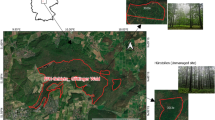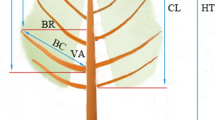Abstract
We analyzed the probability that Betula maximowicziana Regel (monarch birch) would suffer crown dieback (crown-dieback probability) and the basal area growth rate (GB), which was found to be a predisposing stress factor making birch trees susceptible to crown dieback. First, we analyzed the relationship between the probability that birch trees would suffer from crown dieback in 1999 and GB from a period prior to the occurrence of crown dieback (1985–1987), using a data set of repeated measurements on 217 trees. Logistic regression analysis revealed that monarch birch had a larger crown-dieback probability when GB was low in the preceding period. Hence, there were predisposing stress factors that reduced GB and continued to affect trees for at least a decade. Next, we analyzed GB in the same period in relation to symmetrical and asymmetrical competition between trees and found that GB was reduced by symmetrical competition, suggesting that this was one of the predisposing factors for crown dieback. Based on these results, we used selected models for crown-dieback probability and GB to calculate crown-dieback probabilities for individuals with different initial basal areas and experiencing different intensities of symmetrical competition. The predicted crown-dieback probability decreased with decreasing symmetrical competition between trees. We discuss a possible process of crown dieback to death for monarch birch and the use of thinning as a method to reduce the risk of crown dieback.




Similar content being viewed by others
References
Akaike H (1973) Information theory and an extension of the maximum likelihood principle. In: Petrov BN, Csaki F (eds) Second international symposium on information theory. Akademiai Kiado, Budapest, pp 267–281
Bazzaz FA (1996) Plants in changing environments. Cambridge University Press, Cambridge
Bigler C, Bugmann H (2003) Growth-dependent tree mortality models based on tree rings. Can J For Res 33:210–221
Chatterjee S, Hadi AS, Price B (1999) Regression analysis by example (Wiley series in probability and statistics). Wiley, New York
Crawley MJ (2005) Statistics: an introduction using R. Wiley, West Sussex
Duchesne L, Ouimet R, Morneau C (2003) Assessment of sugar maple health based on basal area growth pattern. Can J For Res 33:2074–2080
Hara H, Higashiura Y, Horahira K, Takahashi Y (1997) Dieback and mortality of Betula maximowicziana, defoliated by Operophtera brumatra. For Protect 257:7–8 (in Japanese)
Hatakeyama S (2004) Distribution range and characteristics of spontaneous birch in Hokkaido. For Tree Breed Hokkaido 46:1–4
Hogg EH, James PB, Kochtubajda B (2002) Growth and dieback of aspen forests in northwestern Alberta, Canada, in relation to climate and insects. Can J For Res 32:823–832
Hokkaido Government (1953) Forest history of Hokkaido. Hokkaido Government, Hokkaido
Hokkaido Government (1979) Report on experimental forest management. Hokkaido Government, Hokkaido, pp 198–208
Hon-ami T, Era T, Shimoma Y, Terazawa K, Hayashi N (2000) Ecological observations and growth pattern of declining Betula maximowicziana hardwood stands in the Okoppe region, northern Hokkaido. North For Jpn 52:173–176
Ito K, Fukuyama K, Higashiura Y, Hara H (1997) Forest damage by insects in Hokkaido in 1996. North For Jpn 49:8–11
Kikuzawa K, Takahashi S, Asai T, Mizui N, Fukuchi M, Mizutani E (1981) Growth rate of a Betula maximowicziana-dominated forest. In: Transactions of the 29th annual meeting of the Hokkaido branch of Japanese Forestry Society, pp 46–48
Koike T (1990) Autumn coloring, photosynthetic performance and leaf development of deciduous broad-leaved trees in relation to forest succession. Tree Physiol 7:21–32
Kolb TE, McCormick LH (1993) Etiology of sugar maple decline in four Pennsylvania stands. Can J For Res 23:2395–2402
Land Bureau, National Land Agency (1975) Land classification map (Hokkaido IV: Kamikawa District). Land Bureau, National Land Agency, Tokyo
Lussier J-M, Morin H, Gagnon R (2002) Mortality in black spruce stands of fire or clear-cut origin. Can J For Res 32:539–547
Manion PD (1991) Tree disease concepts. Prentice-Hall, Englewood Cliffs
Mukaide H (1985) Working methods for the broad-leaved forest in Hokkaido—Hardwood resource. Jpn J For Environ 27:13–18
Ohno Y, Umeki K, Watanabe I, Takiya M, Terazawa K, Hara H, Matsuki S (2008) Variation in shoot mortality within crowns of severely defoliated Betula maximowicziana trees in Hokkaido, northern Japan. Ecol Res 23:355–362
Ohno Y, Umeki K, Watanabe I, Takiya M, Terazawa K, Yasaka M, Matsuki S (2009) Basal area growth and mortality of Betula maximowicziana affected by crown dieback in a secondary forest in Hokkaido, northern Japan. J For Res 14:37–43
Pedersen BS (1998) The role of stress in the mortality of midwestern oaks as indicated by growth prior to death. Ecology 79:79–93
Ryan MG, Yoder BJ (1997) Hydraulic limits to tree height and tree growth. Bioscience 47:235–242
Schwinning S, Weiner J (1998) Mechanisms determining the degree of size asymmetry in competition among plants. Oecologia 113:447–455
Tabata H (1966) A contribution to the biology of Japanese birches. Mem Coll Sci Univ Kyoto Ser B 32:239–271
Terazawa K, Usui G (1987) Distribution and seasonal change of potential evapotranspiration/precipitation from May to October in Hokkaido. Bull Hokkaido For Res Inst 25:36–49
Terazawa K, Koyama H, Watanabe I, Era T, Honami S, Nomura M (2001) Ecological observations and preliminary analysis of declining fire-origin hardwood stands dominated by Betula species in the Okoppe region, northern Hokkaido. In: Transactions of the 49th annual meeting of the Hokkaido branch of Japanese Forestry Society, pp 69–72
Watanabe S (1994) Specia of trees. University of Tokyo Press, Tokyo
Watanabe I, Terazawa K, Yasaka M, Umeki K (2002) Thinning effect and crown dieback in a mature secondary stand of Betula maximowicziana established after fire. Bull Hokkaido For Res Inst 39:55–68
Weiner J (1990) Asymmetric competition in plant populations. Trends Ecol Evol 5:360–364
Yokozawa M, Hara T (1992) A canopy photosynthesis model for the dynamics of size structure and self-thinning in plant populations. Ann Bot 70:305–316
Acknowledgments
We thank Dr Kihachiro Kikuzawa, Sachio Takahashi, Dr Tatsuhiro Asai, Dr Norio Mizui, Minoru Fukuchi, Eiichi Mizutani, Sawako Tokuda, Dr Sawako Matsuki, Kenji Yamamoto, Shigeharu Tsuchida, and Tomoko Sanada for contributing to the establishment of the study plots and for assistance in the tree censuses. This study was partly supported by Grants-in-Aid from the Ministry of Education, Culture, Sports, Science, and Technology of Japan (No. 20380084 and 20370014).
Author information
Authors and Affiliations
Corresponding author
About this article
Cite this article
Ohno, Y., Umeki, K., Terazawa, K. et al. Competition as a predisposing factor of crown dieback in a secondary forest of Betula maximowicziana in Hokkaido, northern Japan. J For Res 15, 161–168 (2010). https://doi.org/10.1007/s10310-009-0168-y
Received:
Accepted:
Published:
Issue Date:
DOI: https://doi.org/10.1007/s10310-009-0168-y




